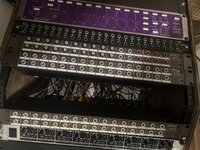Dahoxic
New member
Hey guys, a bit of a doozy here....
I have a tascam m520 and I'm trying to plug the direct out (out of a patchbay) to the input on an Apogee AD 8000 AD/DA convertor. Problem is that there is a slight distortion harmonic introduced to the signal in the background when making this patch happen, I found that when the buss is unassigned I can still hear the by distortion by itself and it's just enough to throw off what I'm trying to record because it's present in the channel. Best I can describe it is some weird harmonic distortion that bleeds back (cross talk?) into the channel fader of the direct out I'm using. The volume of said bleed is controllable via the fader. Interestingly if I patch this direct out into my presonus 1824, the distortion does not bleed back into the channel. Why not just use the presonus? Well because I spent good money on the apogee and I want to make sure I'm using it right as it's a superior convertor. (hooked up via adat to the presonus word clock yadda yadda)
So far I've tried patching a bus into the apogee input, same problem. I've tried using the balance amp on the tascam (balanced patchbay with a balance patch cable to preserve balance integrity in this instance), same problem. I've tried switching pin 2 hot to pin 3 hot on the apogee, same problem. I've tried enabling and disabling analog/digital DC coupling on the apogee, no dice. I've switched patchbays between a neutrik nys and an unbalanced tascam patchbay and that didn't change anything. I've tried different patch cables.
So what am I doing incorrectly? Is this some sort of impedance mismatch? Poor grounding? Bad capacitance? I'm at a loss and I could use any help y'all might be able to give.
You might suggest it's the input of the apogee itself, but I've recorded signals off my phone into the daw from the bay and there was no audible distortion. So it's gotta be something about interfacing this console with the apogee yeah?
I have a tascam m520 and I'm trying to plug the direct out (out of a patchbay) to the input on an Apogee AD 8000 AD/DA convertor. Problem is that there is a slight distortion harmonic introduced to the signal in the background when making this patch happen, I found that when the buss is unassigned I can still hear the by distortion by itself and it's just enough to throw off what I'm trying to record because it's present in the channel. Best I can describe it is some weird harmonic distortion that bleeds back (cross talk?) into the channel fader of the direct out I'm using. The volume of said bleed is controllable via the fader. Interestingly if I patch this direct out into my presonus 1824, the distortion does not bleed back into the channel. Why not just use the presonus? Well because I spent good money on the apogee and I want to make sure I'm using it right as it's a superior convertor. (hooked up via adat to the presonus word clock yadda yadda)
So far I've tried patching a bus into the apogee input, same problem. I've tried using the balance amp on the tascam (balanced patchbay with a balance patch cable to preserve balance integrity in this instance), same problem. I've tried switching pin 2 hot to pin 3 hot on the apogee, same problem. I've tried enabling and disabling analog/digital DC coupling on the apogee, no dice. I've switched patchbays between a neutrik nys and an unbalanced tascam patchbay and that didn't change anything. I've tried different patch cables.
So what am I doing incorrectly? Is this some sort of impedance mismatch? Poor grounding? Bad capacitance? I'm at a loss and I could use any help y'all might be able to give.
You might suggest it's the input of the apogee itself, but I've recorded signals off my phone into the daw from the bay and there was no audible distortion. So it's gotta be something about interfacing this console with the apogee yeah?

